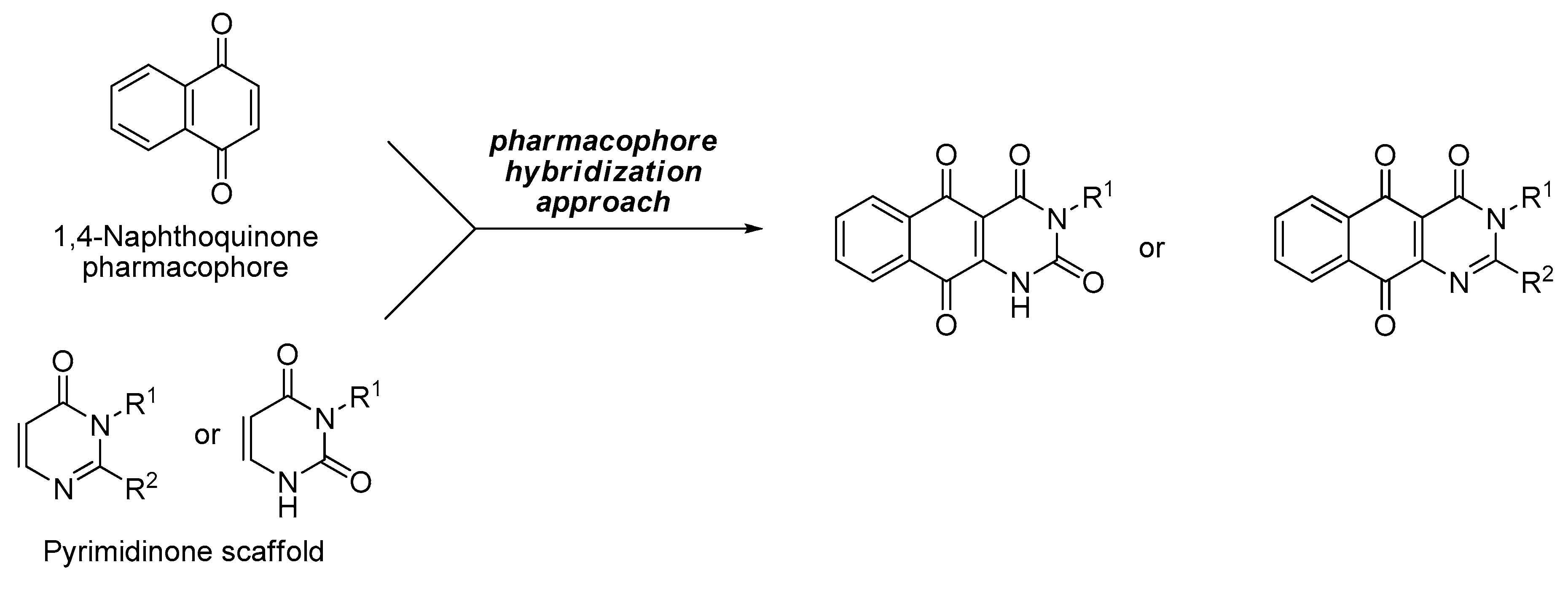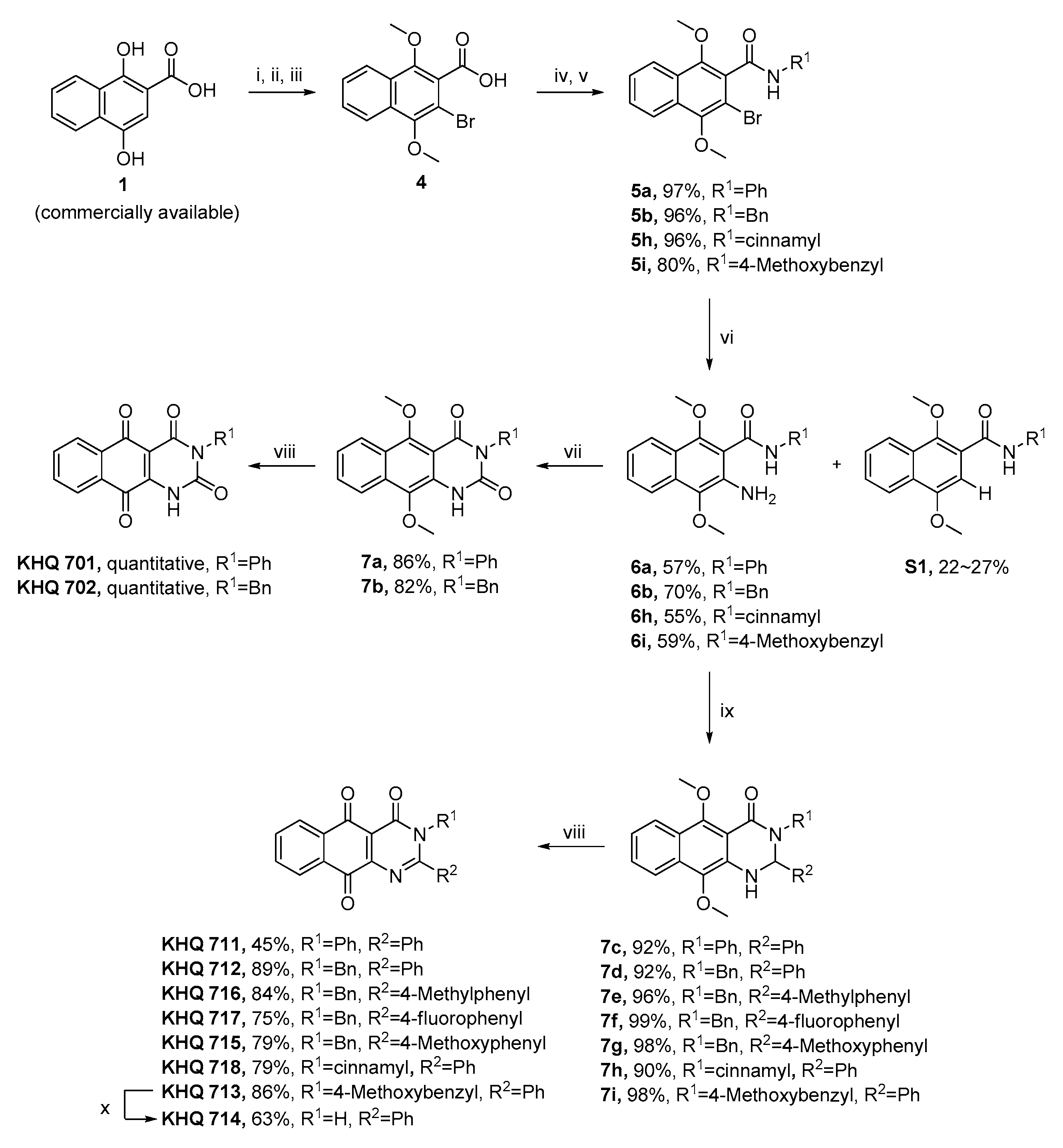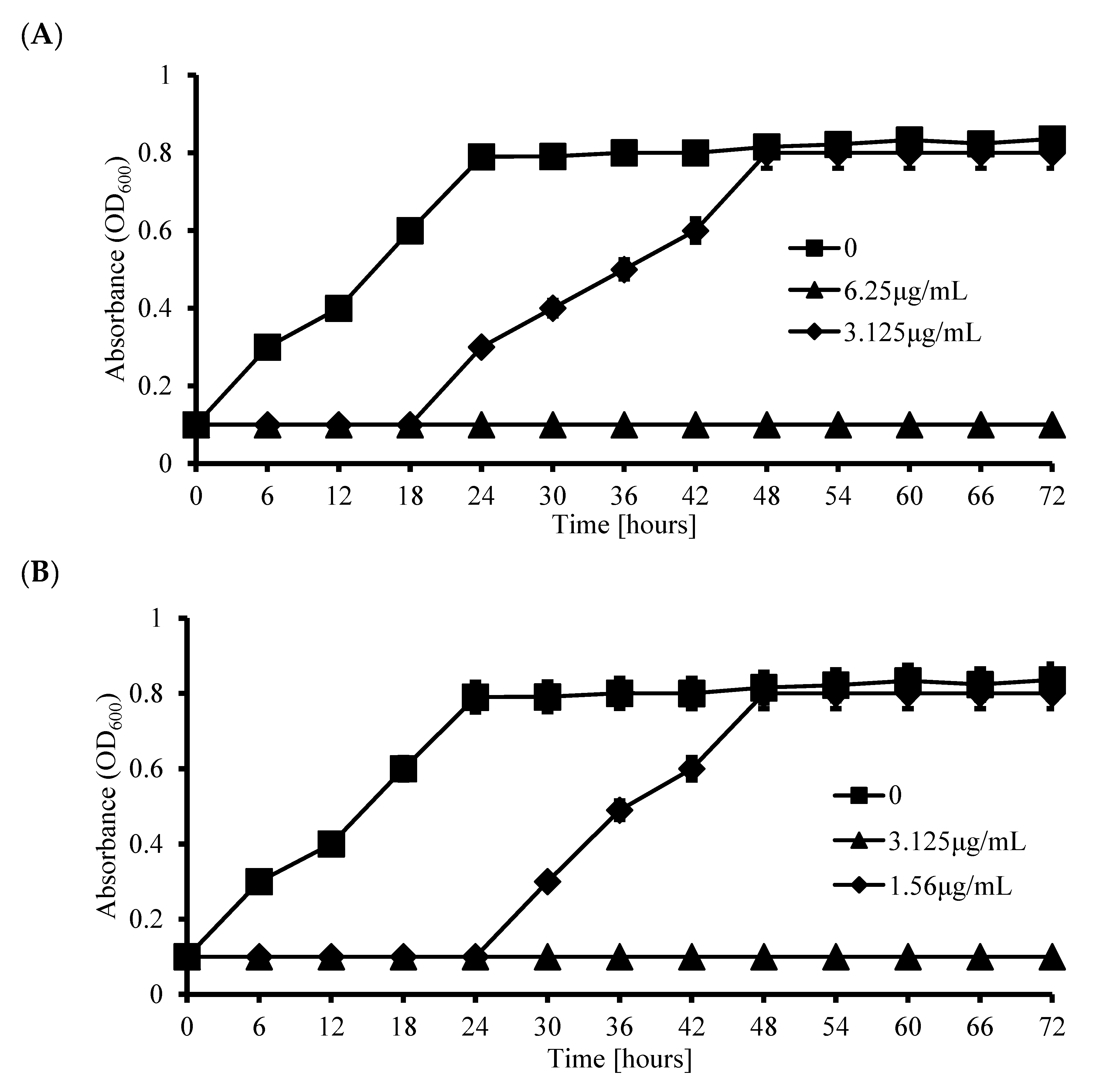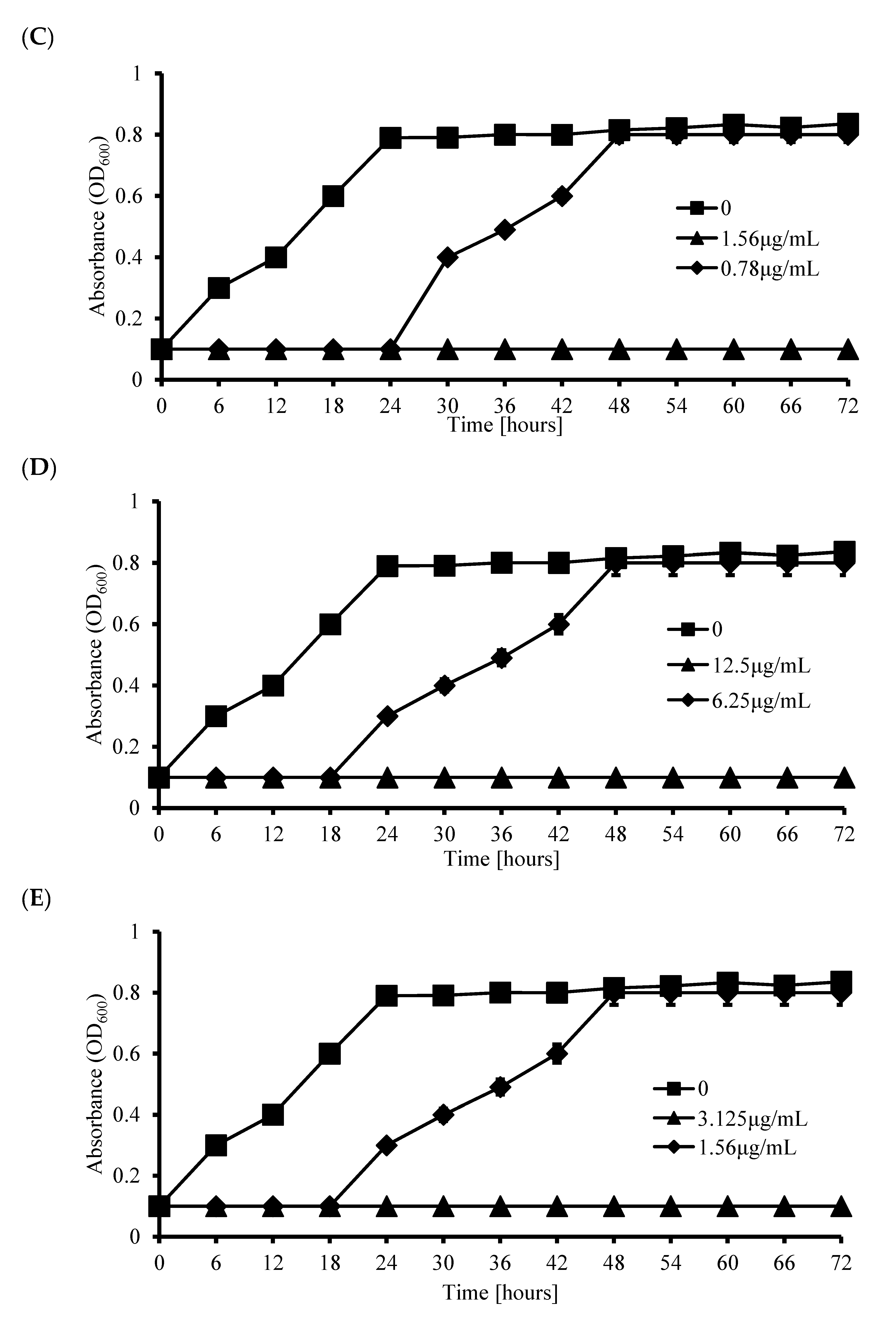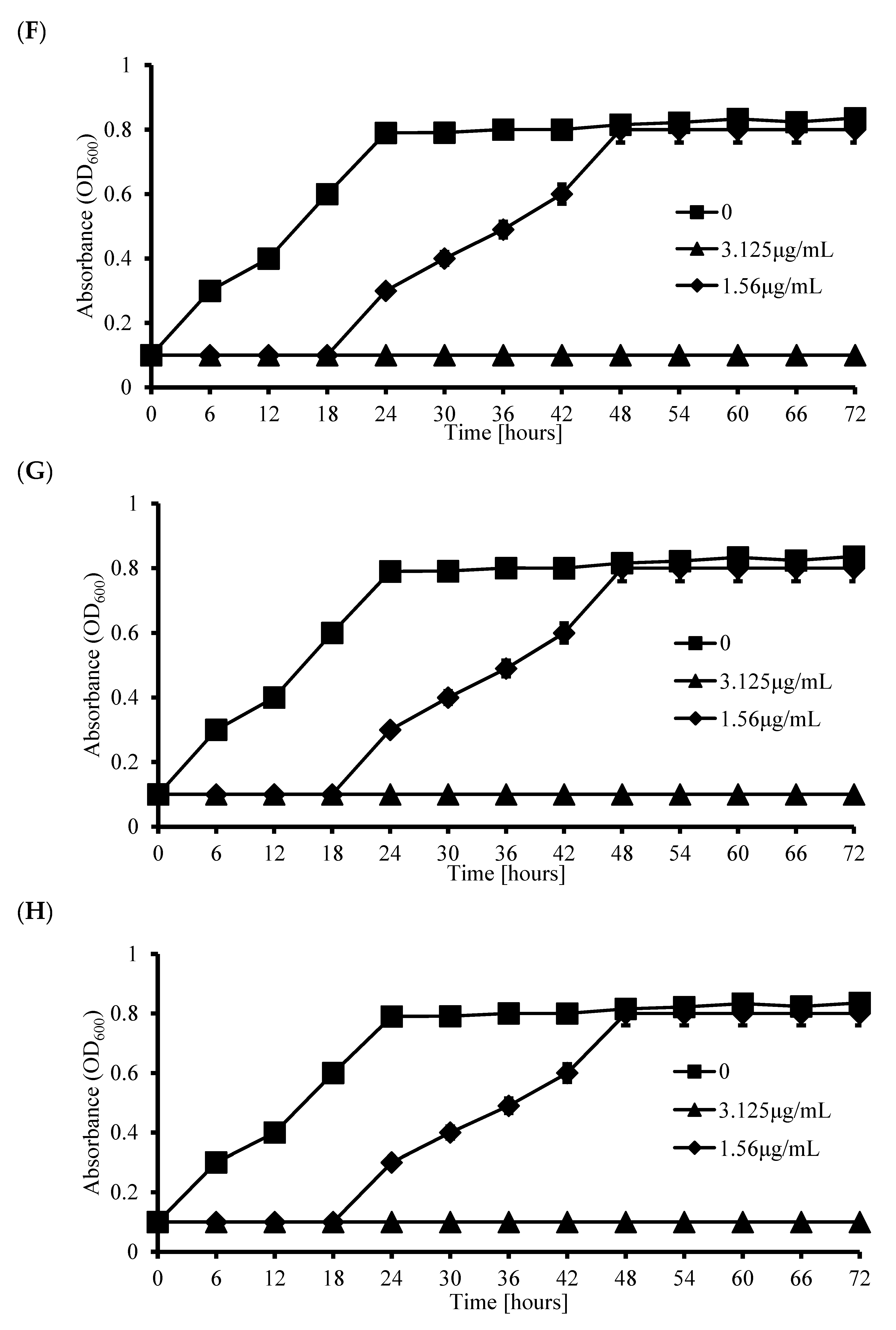2.1. General Experimental Details for Synthesis of Compounds
All chemical reagents were purchased from Sigma-Aldrich, Tokyo Chemical Industry, Alfa Aesar and Acros Organics, and were used without further purification. All glassware was thoroughly dried in a convection oven. Reactions were monitored using thin-layer chromatography (TLC). Commercial TLC plates (silica gel 60 F254, Merck Co.) were developed and the spots were visualized under UV light at 254 or 365 nm. Silica gel column chromatography was performed with silica gel 60 (particle size 0.040−0.063 mm, Merck Co.). Extra pure-grade solvents for column chromatography were purchased through Samchun Chemicals and Duksan Chemicals. 1H and 13C NMR spectra were collected with a JEOL ECX-400 spectrometer (at 300 MHz for 1H NMR and 75 MHz for 13C NMR), and the chemical shifts were recorded with respect to tetramethylsilane, Si(CH3)4, as an internal reference or were referenced to the residual proton peaks of the deuterated solvent. Mass spectrometry (MS) spectra were recorded using a Bruker compact ESI quadrupole-TOF ultra-high-resolution liquid chromatograph/mass spectrometer.
2.1.1. Preparation of 3-bromo-1, 4-dimethoxy-2-naphthoic acid (4)
Methyl 3-bromo-1, 4-dimethoxy-2-naphthoate (3). To a solution of methyl 1,4-dimethoxy-2-naphthoate (2, 7.7 g, 31.3 mmol) in 78 mL of N,N-dimethylformamide (DMF), N-bromosuccinimide (NBS, 34.4 mmol, 6.1 g) was slowly added at room temperature and it was stirred overnight. After completion of the reaction, it was concentrated in vacuo and treated with ethyl acetate and water. The organic layer was separated, washed with brine and dried over Na2SO4. After filtration, the crude residue was purified by a silica gel flash column chromatography (17% ethyl acetate/hexane) to give compound 3 as a white solid (10.0 g, 98%): 1H NMR (DMSO-d6, 300 MHz) δ ppm 8.13–8.09 (m, 2H), 7.74–7.71 (m, 2H), 3.93 (s, 3H), 3.91 (s, 3H), 3.91 (s, 3H); 13C NMR (CDCl3, 75 MHz) δ ppm 166.60, 150.28, 150.23, 129.55, 128.10, 127.77, 127.13, 126.42, 123.06, 122.63, 108.57, 63.73, 61.59, 52.86.
3-Bromo-1,4-dimethoxy-2-naphthoic acid (4). Methyl 3-bromo-1,4-dimethoxy-2-naphthoate (3, 15.7 g, 48.4 mmol) was dissolved in 50 mL of tetrahydrofuran (THF), 50 mL of methanol and 100 mL of water. Potassium hydroxide (241.7 mmol, 13.6 g) was added at room temperature and the reaction mixture was refluxed for 48 h or until all the starting material was consumed. After completion of the reaction, the mixture was cooled to room temperature. The reaction mixture was washed with a saturated aqueous solution of K2CO3 and brine. After filtration, the residue was washed with a hexane and dissolved in water. The mixture was acidified with concentrated HCl. After filtration, the residue was washed with water and hexane. Compound 4 was obtained as a white solid (12.1 g, 84%): 1H NMR (DMSO-d6, 300 MHz) δ ppm 13.75 (s, 1H), 8.13–8.06 (m, 2H), 7.73–7.67 (m, 2H), 3.92 (s, 3H), 3.90 (s, 3H); 13C NMR (CDCl3, 75 MHz) δ ppm 171.19, 150.56, 150.43, 129.78, 128.37, 127.75, 127.27, 125.58, 123.19, 122.70, 108.15, 64.08, 61.65.
2.1.2. Synthesis of 5a−5i from Naphthoic Acid
3-Bromo-1,4-dimethoxy-N-phenyl-2-naphthamide (5a). 3-Bromo-1,4-dimethoxy-2-naphthoic acid (4, 0.50 g, 1.6 mmol) was dissolved in 8 mL of anhydrous dichloromethane (DMC) and catalytic amount of anhydrous DMF under argon. Oxalyl chloride (0.23 mL, 2.7 mmol) was added dropwise at room temperature and the reaction was left to stir for 3 h. The solution was evaporated under reduced pressure and the oily residue was dried under high vacuum for 1 hour to ensure all the oxalyl chloride was removed. Without further purification, the oily residue was dissolved in 13 mL of anhydrous DMC and 0.32 mL anhydrous pyridine under argon. Aniline (0.18 mL, 1.9 mmol) was added dropwise and the reaction mixture was stirred at room temperature overnight. After completion of the reaction, the mixture was quenched with 3 M HCl at 0 °C and extracted with DMC. The organic layer was separated, washed with brine and dried over Na2SO4. After filtration, the crude residue was purified by a silica gel flash column chromatography (20% ethyl acetate/hexane) to give compound 5a as a white solid (0.601 g, 97% yield over two steps): 1H NMR (DMSO-d6, 300 MHz) δ ppm 10.60 (s, 1H), 8.14–8.11 (m, 2H), 7.73–7.70 (m, 4H), 7.36 (t, 2H, J = 7.9 Hz), 7.14–7.09 (m, 1H), 3.93 (s, 6H); 13C NMR (DMSO-d6, 75 MHz) δ ppm 163.34, 149.41, 149.17, 138.92, 129.75, 128.85, 128.46, 128.24, 127.54, 127.41, 123.82, 122.92, 122.34, 119.46, 109.74, 63.43, 61.40.
N-Benzyl-3-bromo-1,4-dimethoxy-2-naphthamide (5b). Following the procedure described above for the preparation of 5a, compound 5b was obtained from benzylamine (0.42 mL, 3.9 mmol) as a white solid (1.2 g, 96% yield over two steps): 1H NMR (DMSO-d6, 300 MHz) δ ppm 9.06 (t, 1H, J = 5.8 Hz), 8.10–8.08 (m, 2H), 7.69–7.66 (m, 2H), 7.46–7.34 (m, 4H), 7.26 (t, 1H, J = 7.1 Hz), 4.51 (d, 2H, J = 5.7 Hz), 3.90 (s, 3H), 3.85 (s, 3H); 13C NMR (CDCl3, 75 MHz) δ ppm 165.75, 150.28, 150.05, 137.65, 129.32, 128.93, 128.69, 128.05, 127.99, 127.94, 127.63, 127.10, 122.91, 122.54, 109.71, 63.92, 61.51, 44.12.
3-Bromo-N-cinnamyl-1,4-dimethoxy-2-naphthamide (5h). Following the procedure described above for the preparation of 5a, compound 5h was obtained from cinnamylamine (0.36 g, 2.7 mmol) as a white solid (0.871 g, 90% yield over two steps): 1H NMR (DMSO-d6, 300 MHz) δ ppm 8.82 (t, 1H, J = 5.7 Hz), 8.11–8.09 (m, 2H), 7.70–7.67 (m, 2H), 7.43 (d, 2H, J = 7.9 Hz), 7.34 (t, 2H, J = 7.5 Hz), 7.27–7.22 (m, 1H), 6.70 (d, 1H, J = 15.9 Hz), 6.39–6.32 (m, 1H), 4.08 (t, 2H, J = 5.3 Hz), 3.92 (s, 3H), 3.90 (s, 3H); 13C NMR (CDCl3, 75 MHz) δ ppm 165.77, 150.29, 150.05, 136.55, 132.39, 129.33, 128.96, 128.60, 127.97, 127.93, 127.74, 127.13, 126.39, 124.90, 122.94, 122.56, 109.69, 63.96, 61.53, 41.95.
3-Bromo-1,4-dimethoxy-N-(4-methoxybenzyl)-2-naphthamide (5i). Following the procedure described above for the preparation of 5a, compound 5i was obtained from 4-methoxybenzylamine (1.0 mL, 7.7 mmol) as a white solid (2.2 g, 80% yield over two steps): 1H NMR (DMSO-d6, 300 MHz) δ ppm 8.98 (t, 1H, J = 5.9 Hz) 8.10–8.06 (m, 2H), 7.70–7.67 (m, 2H), 7.35 (d, 2H, J = 8.4 Hz), 6.92 (d, 2H, J = 8.6 Hz), 4.43 (d, 2H, J = 5.7 Hz), 3.89 (s, 3H), 3.85 (s, 3H), 3.74 (s, 3H); 13C NMR (CDCl3, 75 MHz) δ ppm 165.64, 159.08, 150.24, 150.02, 129.73, 129.39, 129.28, 128.95, 127.93, 127.88, 127.08, 122.90, 122.52, 114.04, 109.74, 63.91, 61.50, 55.28, 43.61.
2.1.3. Synthesis of 6a-6i from 5a−5i
3-Amino-1,4-dimethoxy-N-phenyl-2-naphthamide (6a). 3-Bromo-1,4-dimethoxy-N-phenyl-2-naphthamide (0.54 g, 1.4 mmol), copper iodide (0.27 g, 1.4 mmol), L-proline (0.21 g, 1.8 mmol), and sodium azide (0.18 g, 2.8 mmol) were dissolved in 2.8 mL of anhydrous dimethyl sulfoxide (DMSO) under argon. The reaction mixture was stirred at 100 °C for 3 h. After completion of the reaction, the solution was cooled to room temperature and quenched by the addition of saturated aqueous NH4Cl and ethyl acetate. This biphasic mixture was stirred at room temperature for 1 hour. The resulting solution was filtered through a pad of celite which was subsequently washed with ethyl acetate and water. The filtrate was transferred to a separatory funnel, the aqueous phase was removed and the organic phase was washed with a saturated NaHCO3 solution and brine. The aqueous phases were combined and extracted with ethyl acetate. This washing/extraction procedure was repeated two additional times. Finally, the organic phases were combined, dried over Na2SO4, concentrated under reduced pressure, and purified by the silica gel flash column chromatography with 14% ethyl acetate/hexane. Compound 6a was obtained as a yellow solid (0.254 g, 57%): 1H NMR (DMSO-d6, 300 MHz) δ ppm 10.47 (s, 1H), 7.93 (d, 1H, J = 8.3 Hz) 7.81–7.76 (m, 3H) 7.48 (t, 1H, J = 7.5 Hz), 7.35 (t, 2H, J = 7.8 Hz), 7.26 (t, 1H, J = 7.5 Hz), 7.11 (t, 1H, J = 7.4 Hz), 5.08 (d, 2H, J = 5.1 Hz), 3.84 (s, 3H), 3.75 (s, 3H); 13C NMR (CDCl3, 75 MHz) δ ppm 165.14, 152.06, 137.95, 137.71, 136.51, 129.89, 129.10, 128.35, 124.60, 123.10, 122.77, 120.45, 120.37, 120.05, 113.13, 63.53, 59.68.
3-Amino-N-benzyl-1,4-dimethoxy-2-naphthamide (6b). Following the procedure described above for the preparation of 6a, compound 6b was obtained from 5b (0.71 g, 1.8 mmol) as a yellowish brown solid (0.418 g, 70%): 1H NMR (DMSO-d6, 300 MHz) δ ppm 8.99 (t, 1H, J = 7.8 Hz), 7.89 (d, 1H, J = 8.4 Hz), 7.76 (d, 1H, J = 8.4 Hz), 7.47–7.33 (m, 5H), 7.28–7.21 (m, 2H), 5.11 (d, 2H, J = 5.5 Hz), 4.50 (d, 2H, J = 6.0 Hz), 3.73 (s, 3H), 3.72 (s, 3H); 13C NMR (CDCl3, 75 MHz) δ ppm 166.84, 152.14, 138.11, 137.53, 136.32, 129.71, 128.76, 128.07, 128.02, 127.56, 123.05, 122.56, 120.52, 120.00, 113.13, 63.23, 59.65, 43.81.
3-Amino-N-cinnamyl-1,4-dimethoxy-2-naphthamide (6h). Following the procedure described above for the preparation of 6a, compound 6h was obtained from 5h (0.65 g, 1.5 mmol) as a bright yellow solid (0.31 g, 55%): 1H NMR (DMSO-d6, 300 MHz) δ ppm 8.74 (t, 1H, J = 5.6 Hz), 7.91 (d, 1H, J = 8.4 Hz), 7.76 (d, 1H, J = 8.4 Hz), 7.48–7.43 (m, 3H), 7.34 (t, 2H, J = 7.4 Hz), 7.26–7.22 (m, 2H), 6.65 (d, 1H, J = 16.1 Hz), 6.43–6.34 (m, 1H), 5.13 (d, 2H, J = 5.7 Hz), 4.10 (t, 2H, J = 5.5 Hz), 3.83 (s, 3H), 3.73 (s, 3H); 13C NMR (CDCl3, 75 MHz) δ ppm 166.86, 152.11, 137.46, 136.53, 136.33, 132.48, 129.71, 128.60, 128.08, 127.75, 126.38, 125.13, 123.08, 122.60, 120.56, 120.01, 113.22, 63.24, 59.67, 41.66.
3-Amino-1,4-dimethoxy-N-(4-methoxybenzyl)-2-naphthamide (6i). Following the procedure described above for the preparation of 6a, compound 6i was obtained from 5i (0.65 g, 1.5 mmol) as a yellowish brown solid (0.33 g, 59%): 1H NMR (DMSO-d6, 300 MHz) δ ppm 8.92 (t, 1H, J = 5.9 Hz), 7.88 (d, 1H, J = 8.4 Hz), 7.75 (d, 1H, J = 8.4 Hz), 7.47–7.42 (m, 1H), 7.34 (d, 2H, J = 8.3 Hz), 7.23 (t, 1H, J = 7.6 Hz), 6.92 (d, 2H, J = 8.4 Hz), 5.11 (d, 2H, J = 5.7 Hz), 4.43 (d, 2H, J = 5.9 Hz), 3.74 (s, 3H), 3.72 (s, 3H), 3.70 (s, 3H); 13C NMR (CDCl3, 75 MHz) δ ppm 166.71, 159.02, 152.08, 137.49, 136.28, 130.22, 129.66, 129.37, 128.03, 123.00, 122.52, 120.53, 119.98, 114.09, 113.20, 63.20, 59.63, 55.27, 43.25.
2.1.4. Synthesis of 7a or 7b from 6a or 6b
5,10-Dimethoxy-3-phenylbenzo[g]quinazoline-2,4(1H,3H)-dione (7a). 3-Amino-1,4-dimethoxy-N-phenyl-2-naphthamide (150 mg, 0.47 mmol) and triphosgene (69 mg, 0.23 mmol) were dissolved in 9.3 mL THF. The reaction mixture was refluxed for 3 h. After completion of the reaction, the mixture was cooled to room temperature and treated with ethyl acetate and water. The organic layer was separated, washed with a brine and dried over Na2SO4. After filtration, the crude residue was purified by a silica gel flash column chromatography (33% ethyl acetate/hexane) to give compound 7a as a bright yellow solid (0.139 g, 86%): 1H NMR (DMSO-d6, 300 MHz) δ ppm 11.02 (s, 1H), 8.21 (d, 1H, J = 8.4 Hz), 8.02 (d, 1H, J = 9.0 Hz), 7.74–7.69 (m, 1H), 7.55–7.42 (m, 4H), 7.34 (d, 2H, J = 7.9 Hz), 3.90 (s, 3H), 3.87 (s, 3H); 13C NMR (CDCl3, 75 MHz) δ ppm 160.56, 156.69, 150.35, 135.55, 134.96, 131.02, 130.03, 129.43, 128.82, 128.80, 126.66, 125.55, 125.35, 124.74, 120.94, 106.93, 63.61, 62.03.
3-Benzyl-5,10-dimethoxybenzo[g]quinazoline-2,4(1H,3H)-dione (7b). Following the procedure described above for the preparation of 7a, compound 7b was obtained from 6b (160 mg, 0.48 mmol) as a white yellow solid (0.142 g, 82%): 1H NMR (DMSO-d6, 300 MHz) δ ppm 11.02 (s, 1H), 8.21 (d, 1H, J = 8.4 Hz), 8.01 (d, 1H, J = 8.4 Hz), 7.72–7.67 (m, 1H), 7.54–7.49 (m, 1H), 7.36–7.23 (m, 5H), 5.12 (s, 2H), 3.92 (s, 3H), 3.84 (s, 3H); 13C NMR (CDCl3, 75 MHz) δ ppm 160.21, 156.26, 150.50, 137.09, 135.37, 130.81, 129.84, 128.96, 128.39, 127.50, 126.57, 125.35, 125.19, 124.58, 120.80, 106.76, 63.48, 61.96, 43.88.
2.1.5. Synthesis of KHQ 701 or KHQ 702 from 7a or 7b
3-Phenylbenzo[g]quinazoline-2,4,5,10(1H,3H)-tetraone (KHQ 701). To a solution of 5,10-dimethoxy-3-phenylbenzo[g]quinazoline-2,4(1H,3H)-dione (80 mg, 0.23 mmol) in 2.0 mL acetonitrile and 2.0 mL DMF, CAN (567 mg, 1.03 mmol) in 2.0 mL of distilled water was slowly added at 0 °C for 10 min. After the addition was complete, the mixture was stirred for an additional 1 hour at room temperature. The resulting mixture was treated with ethyl acetate and water. The organic layer was separated, washed with a brine and dried over Na2SO4. After filtration, the crude residue was purified by a silica gel flash column chromatography (50% ethyl acetate/hexane, 100% ethyl acetate, 100% dichloromethane and then 20% methanol/dichloromethane) to give compound KHQ 701 as a yellow solid (0.073 g, quantitative): mp 285 °C (decomposed); 1H NMR (DMSO-d6, 300 MHz) δ ppm 12.23 (s, 1H), 8.06 (d, 2H, J = 7.9 Hz), 7.94–7.83 (m, 2H), 7.50–7.40 (m, 3H), 7.21 (d, 2H, J = 7.1 Hz); HRMS (ESI+) for C18H10N2O4Na (M+ •Na) calcd, 341.0533; found, 341.0535.
3-Benzylbenzo[g]quinazoline-2,4,5,10(1H,3H)-tetraone (KHQ 702). Following the procedure described above for the preparation of KHQ 701, compound KHQ 702 was obtained from 7b (0.168 g, 0.46 mmol) as a yellow solid (0.154 g, quantitative).: mp 293 °C (decomposed); 1H NMR (DMSO-d6, 300 MHz) δ ppm 12.18 (s, 1H), 8.05–8.02 (m, 2H), 7.99–7.76 (m, 2H), 7.28–7.21 (m, 5H), 5.01 (s, 2H); HRMS (ESI+) for C19H12N2O4Na (M+•Na) calcd, 355.0689; found, 355.0691.
2.1.6. Synthesis of 7c−7i from 6a-6i
5,10-dimethoxy-2,3-diphenyl-2,3-dihydrobenzo[g]quinazolin-4(1H)-one (7c). 3-Amino-1,4-dimethoxy-N-phenyl-2-naphthamide (150 mg, 0.47 mmol) and p-toluenesulfonic acid monohydrate (8.9 mg, 0.047 mmol) were dissolved in 4.7 mL THF. Benzaldehyde (0.071 mL, 0.70 mmol) was added dropwise at room temperature. After stirring at 40 °C for 6 h, the resulting mixture was treated with ethyl acetate and water. The organic layer was separated, washed with a brine and dried over Na2SO4. After filtration, the mixture was concentrated under reduced pressure, and the crude residue was purified by a silica gel flash column chromatography (10% ethyl acetate/hexane) to give compound 7c as a yellow solid (0.176 g, 92%).: 1H NMR (DMSO-d6, 300 MHz) δ ppm 8.03 (d, 1H, J = 8.3 Hz), 7.72 (d, 1H, J = 8.4 Hz), 7.50–7.47 (m, 4H), 7.43–7.40 (m, 4H), 7.32–7.23 (m, 5H), 6.15 (d, NH, J = 3.1 Hz), 3.93 (s, 3H), 3.66 (s, 3H); 13C NMR (DMSO-d6, 75 MHz) δ ppm 160.07, 155.13, 141.26, 140.69, 135.07, 134.62, 130.37, 128.94, 128.91, 128.78, 128.42, 128.12, 126.23, 125.64, 123.80, 122.91, 122.14, 119.53, 110.19, 72.19, 62.37, 60.40.
3-Benzyl-5,10-dimethoxy-2-phenyl-2,3-dihydrobenzo[g]quinazolin-4(1H)-one (7d). Following the procedure described above for the preparation of 7c, compound 7d was obtained from 6b (80 mg, 0.24 mmol) as a yellow solid (0.093 g, 92%).: 1H NMR (DMSO-d6, 300 MHz) δ ppm 8.01 (d, 1H, J = 7.9 Hz), 7.68 (d, 1H, J = 8.4 Hz), 7.49–7.44 (m, 1H), 7.42–7.33 (m, 6H), 7.30–7.21 (m, 6H), 5.73 (d, NH, J = 3.3 Hz), 5.47 (d, 1H, J = 15.4 Hz), 4.03 (d, 1H, J = 15.2 Hz), 3.94 (s, 3H), 3.58 (s, 3H); 13C NMR (CDCl3, 75 MHz) δ ppm 161.14, 155.59, 139.38, 136.90, 135.16, 134.49, 130.73, 129.03, 128.96, 128.94, 128.63, 128.03, 127.46, 126.11, 124.51, 123.94, 123.26, 119.82, 109.95, 70.38, 63.27, 60.62, 47.35.
3-Benzyl-5,10-dimethoxy-2-p-tolyl-2,3-dihydrobenzo[g]quinazolin-4(1H)-one (7e). Following the procedure described above for the preparation of 7c, compound 7e was obtained from 6b (100 mg, 0.30 mmol) as a bright yellow solid (0.125 g, 96%).: 1H NMR (DMSO-d6, 300 MHz) δ ppm 8.01 (d, 1H, J = 8.3 Hz), 7.67 (d, 1H, J = 8.3 Hz), 7.47 (t, 1H, J = 7.5 Hz), 7.41–7.33 (m, 4H), 7.30–7.21 (m, 4H), 7.16 (d, 1H, J = 3.1 Hz), 7.07 (d, 2H, J = 8.1 Hz), 5.68 (d, NH, J = 2.9 Hz), 5.48 (d, 1H, J = 15.2 Hz), 3.99 (d, 1H, J = 15.4 Hz), 3.94 (s, 3H), 3.58 (s, 3H), 2.17 (s, 3H); 13C NMR (CDCl3, 75 MHz) δ ppm 161.19, 155.55, 138.94, 136.99, 136.39, 135.15, 134.63, 130.72, 129.57, 128.62, 128.59, 128.02, 127.41, 126.08, 124.51, 123.90, 123.21, 119.81, 110.01, 70.19, 63.26, 60.62, 47.27, 21.07.
3-Benzyl-2-(4-fluorophenyl)-5,10-dimethoxy-2,3-dihydrobenzo[g]quinazolin-4(1H)-one (7f). Following the procedure described above for the preparation of 7c, compound 7f was obtained as a bright yellow solid (170 mg, 99%) by reaction with 6b (0.130 g, 0.39 mmol).: 1H NMR (DMSO-d6, 300 MHz) δ ppm 8.02 (d, 1H, J = 8.4 Hz), 7.69 (d, 1H, J = 8.0 Hz), 7.48 (t, 1H, J = 7.4 Hz), 7.42–7.33 (m, 6H), 7.30–7.25 (m, 2H), 7.23–7.20 (m, 1H), 7.11 (t, 2H, J = 8.9 Hz), 5.74 (d, NH, J = 3.8 Hz), 5.43 (d, 1H, J = 15.4 Hz), 4.07 (d, 1H, J = 15.2 Hz), 3.94 (s, 3H), 3.58 (s, 3H); 13C NMR (CDCl3, 75 MHz) δ ppm 164.58, 161.30, 161.04, 155.64, 136.74, 135.28, 135.24, 135.22, 134.26, 130.74, 128.74, 128.65, 128.07, 127.98, 127.97, 127.50, 124.51, 123.98, 123.40, 119.84, 115.99, 115.71, 109.82, 69.85, 63.30, 60.64, 47.32.
3-Benzyl-5,10-dimethoxy-2-(4-methoxyphenyl)-2,3-dihydrobenzo[g]quinazolin-4(1H)-one (7g). Following the procedure described above for the preparation of 7c, compound 7g was obtained as a bright yellow solid (198 mg, 98%) by reaction with 6b (0.150 g, 0.45 mmol).: 1H NMR (DMSO-d6, 300 MHz) δ ppm 8.01 (d, 1H, J = 8.4 Hz), 7.68 (d, 1H, J = 8.4 Hz), 7.47 (t, 1H, J = 7.6 Hz), 7.41–7.33 (m, 4H), 7.29–7.24 (m, 4H), 7.12 (d, 1H, J = 2.8 Hz), 6.83 (d, 2H, J = 8.8 Hz), 5.67 (d, NH, J = 2.9 Hz), 5.46 (d, 1H, J = 15.4 Hz), 3.98 (d, 1H, J = 15.5 Hz), 3.94 (s, 3H), 3.64 (s, 3H), 3.58 (s, 3H); 13C NMR (CDCl3, 75 MHz) δ ppm 161.19, 160.08, 155.55, 137.02, 135.14, 134.69, 131.37, 130.71, 128.61, 128.58, 127.98, 127.57, 127.37, 124.50, 123.89, 123.23, 119.82, 114.17, 109.98, 70.12, 63.27, 60.61, 55.26, 47.17.
3-Cinnamyl-5,10-dimethoxy-2-phenyl-2,3-dihydrobenzo[g]quinazolin-4(1H)-one (7h). Following the procedure described above for the preparation of 7c, compound 7h was obtained as a bright yellow solid (167 mg, 90%) by reaction with 6h (0.150 g, 0.41 mmol).: 1H NMR (DMSO-d6, 300 MHz) δ ppm 8.00 (d, 1H, J = 8.6 Hz), 7.68 (d, 1H, J = 8.3 Hz), 7.49–7.38 (m, 5H), 7.34–7.18 (m, 8H), 6.67 (d, 1H, J = 15.7 Hz), 6.38–6.29 (m, 1H), 5.81 (d, NH, J = 3.0 Hz), 4.98–4.91 (m, 1H), 3.93 (s, 3H), 3.76–3.69 (m, 1H), 3.60 (s, 3H); 13C NMR (CDCl3, 75 MHz) δ ppm 160.90, 139.50, 136.51, 135.20, 134.54, 133.22, 130.70, 129.10, 128.96, 128.63, 128.54, 127.72, 126.47, 126.25, 124.50, 124.23, 123.94, 123.29, 119.84, 119.07, 110.08, 70.57, 63.27, 60.64, 46.36.
5,10-Dimethoxy-3-(4-methoxybenzyl)-2-phenyl-2,3-dihydrobenzo[g]quinazolin-4(1H)-one (7i). Following the procedure described above for the preparation of 7c, compound 7i was obtained as a bright yellow solid (332 mg, 98%) by reaction with 6i (0.273 g, 0.75 mmol).: 1H NMR (DMSO-d6, 300 MHz) δ ppm 8.00 (d, 1H, J = 8.4 Hz), 7.67 (d, 1H, J = 8.4 Hz), 7.46 (t, 1H, J = 7.7 Hz), 7.37–7.17 (m, 9H), 6.92 (d, 2H, J = 8.4 Hz), 5.69 (d, NH, J = 3.1 Hz), 5.42 (d, 1H, J = 15.0 Hz), 3.94 (s, 3H), 3.92 (d, 1H, J = 15.4 Hz), 3.73 (s, 3H), 3.57 (s, 3H); 13C NMR (CDCl3, 75 MHz) δ ppm 161.56, 159.05, 155.53, 139.47, 135.13, 134.45, 130.69, 12951, 128.97, 128.91, 128.90, 128.59, 126.08, 124.49, 123.90, 123.23, 119.79, 114.00, 110.00, 70.06, 63.24, 60.60, 55.27, 46.72.
2.1.7. Synthesis of KHQ 711–713, KHQ 715–718 from 7c-7i
2,3-diphenylbenzo[g]quinazoline-4,5,10(3H)-trione (KHQ 711). To a solution of 5,10-dimethoxy-2,3-diphenyl-2,3-dihydrobenzo[g]quinazolin-4(1H)-one (50 mg, 0.12 mmol) in 1.2 mL CH3CN and 1.2 mL DMF, CAN (0.30 g, 0.55 mmol) in 1.2 mL distilled water was added dropwise at 0 °C for 10 min. The mixture was stirred for an additional hour at room temperature open to the air. After completion of the reaction, it was treated with ethyl acetate and water. The organic layer was separated, washed with a brine and dried over Na2SO4. After filtration, the mixture was concentrated in vacuo and purified by a silica gel flash column chromatography (50% ethyl acetate/hexane) to give compound KHQ 711 as a yellow solid (0.121 g, 45%).: mp 242.1–245.7 °C; 1H NMR (DMSO-d6, 300 MHz) δ ppm 8.15–7.84 (m, 4H), 7.46–7.28 (m, 10H); 13C NMR (CDCl3, 75 MHz) δ ppm 180.62, 158.53, 136.54, 135.11, 133.93, 133.78, 133.22, 132.00, 131.68, 130.92, 129.57, 129.30, 129.26, 128.61, 128.50, 128.19, 127.33, 127.11, 127.01, 117.39; HRMS (ESI+) for C24H14N2O3Na (M + •Na) calcd, 401.0897; found, 401.0899.
3-Benzyl-2-phenylbenzo[g]quinazoline-4,5,10(3H)-trione (KHQ 712). Following the procedure described above for the preparation of KHQ 711, compound KHQ 712 was obtained as a yellow solid (99 mg, 89%) by reaction with 7d (0.120 g, 0.28 mmol).: mp 214.3–216.8 °C; 1H NMR (DMSO-d6, 300 MHz) δ ppm 8.10 (d, 2H, J = 8.3 Hz), 7.94–7.88 (m, 2H), 7.58–7.50 (m, 5H), 7.25–7.23 (m, 3H), 7.02–6.99 (m, 2H), 5.21 (s, 2H); 13C NMR (CDCl3, 75 MHz) δ ppm 181.96, 180.81, 166.04, 158.63, 152.96, 135.10, 133.99, 133.78, 133.18, 131.64, 131.21, 128.83, 128.72, 128.69, 128.16, 128.12, 128.06, 127.52, 127.10, 126.98, 49.85; HRMS (ESI+) for C25H16N2O3Na (M + •Na) calcd, 415.1053; found, 415.1054.
3-Benzyl-2-p-tolylbenzo[g]quinazoline-4,5,10(3H)-trione (KHQ 716). Following the procedure described above for the preparation of KHQ 711, compound KHQ 716 was obtained as a yellow solid (93 mg, 84%) by reaction with 7e (0.120 g, 0.27 mmol).: mp 207.8–209.3 °C; 1H NMR (CDCl3, 300 MHz) δ ppm 8.29–8.22 (m, 2H), 7.84–7.77 (m, 2H), 7.38 (d, 2H, J = 8.2 Hz), 7.28 (d, 2H, J = 7.1 Hz), 7.25–7.23 (m, 3H), 7.03–7.00 (m, 2H), 5.38 (s, 2H), 2.43 (s, 3H); 13C NMR (CDCl3, 75 MHz) δ ppm 181.97, 180.77, 166.22, 158.68, 152.91, 141.80, 135.19, 135.00, 133.68, 133.15, 131.60, 131.16, 129.41, 128.66, 128.27, 127.93, 127.42, 127.01, 126.88, 116.86, 49.98, 21.49; HRMS (ESI+) for C26H18N2O3Na (M + •Na) calcd, 429.1210; found, 429.1213.
3-Benzyl-2-(4-fluorophenyl)benzo[g]quinazoline-4,5,10(3H)-trione (KHQ 717). Following the procedure described above for the preparation of KHQ 711, compound KHQ 717 was obtained as a yellow solid (130 mg, 75%) by reaction with 7f (0.188 g, 0.42 mmol).: mp 224.6–228.3 °C; 1H NMR (DMSO-d6, 300 MHz) δ ppm 8.10 (d, 2H, J = 7.5 Hz), 7.94–7.88 (m, 2H), 7.60–7.55 (m, 2H), 7.35 (t, 2H, J = 8.8 Hz), 7.26–7.24 (m, 3H), 7.01 (d, 2H, J = 7.7 Hz), 5.22 (s, 2H); 13C NMR (CDCl3, 75 MHz) δ ppm 181.81, 180.66, 165.87, 165.09, 162.52, 158.54, 152.80, 135.12, 134.99, 133.79, 133.06, 131.52, 130.66, 130.55, 130.15, 130.10, 128.81, 128.09, 127.22, 127.04, 126.92, 117.09, 116.21, 115.91, 49.91; HRMS (ESI + ) for C25H15FN2O3Na (M + •Na) calcd, 433.0959; found, 433.0960.
3-Benzyl-2-(4-methoxyphenyl)benzo[g]quinazoline-4,5,10(3H)-trione (KHQ 715). Following the procedure described above for the preparation of KHQ 711, compound KHQ715 was obtained as a yellow solid (175 mg, 79%) by reaction with 7g (0.188 g, 0.42 mmol).: mp 168.2–172.6 °C; 1H NMR (DMSO-d6, 300 MHz) δ ppm 8.09 (d, 2H, J = 8.1 Hz), 7.96–7.85 (m, 2H), 7.53 (d, 2H, J = 8.6 Hz), 7.30–7.23 (m, 3H), 7.05 (d, 4H, J = 8.6 Hz), 5.27 (s, 2H), 3.81 (s, 3H); 13C NMR (CDCl3, 75 MHz) δ ppm 182.12, 180.81, 165.94, 162.12, 158.92, 152.97, 135.36, 135.06, 133.70, 133.26, 131.69, 130.50, 128.79, 127.98, 127.32, 127.09, 126.94, 126.34, 116.60, 114.24, 55.57, 50.25; HRMS (ESI+) for C26H18N2O4Na (M + •Na) calcd, 445.1159; found, 445.1161.
3-Cinnamyl-2-phenylbenzo[g]quinazoline-4,5,10(3H)-trione (KHQ 718). Following the procedure described above for the preparation of KHQ 711, compound KHQ 718 was obtained as a yellow solid (101 mg, 79%) by reaction with 7h (0.139 g, 0.31 mmol).: mp 256.7–258.1 °C; 1H NMR (DMSO-d6, 300 MHz) δ ppm 8.11 (d, 2H, J = 7.7 Hz), 7.97–7.88 (m, 2H), 7.68–7.58 (m, 5H), 7.37–7.22 (m, 5H), 6.26 (d, 2H, J = 5.3 Hz), 4.69 (d, 2H, J = 3.1 Hz); 13C NMR (CDCl3, 75 MHz) δ ppm 181.94, 180.89, 165.87, 158.42, 153.00, 135.66, 135.28, 135.09, 133.93, 133.78, 133.17, 131.64, 131.26, 128.83, 128.63, 128.33, 128.14, 127.08, 127.00, 126.57, 121.52, 117.10, 49.59; HRMS (ESI + ) for C27H18N2O3Na (M + •Na) calcd, 441.1210; found, 441.1212.
3-(4-Methoxybenzyl)-2-phenylbenzo[g]quinazoline-4,5,10(3H)-trione (KHQ 713). Following the procedure described above for the preparation of KHQ 711, compound KHQ 713 was obtained as a yellow solid (0.36 g, 86%) by reaction with 7i (0.45 g, 0.98 mmol).: mp 201.7–206.3 °C; 1H NMR (DMSO-d6, 300 MHz) δ ppm 8.09 (d, 2H, J = 7.7 Hz), 7.94–7.87 (m, 2H), 7.60–7.52 (m, 5H), 6.90 (d, 2H, J = 8.6 Hz), 6.79 (d, 2H, J = 8.6 Hz), 5.15 (s, 2H), 3.68 (s, 3H); 13C NMR (CDCl3, 75 MHz) δ ppm 181.92, 180.80, 165.88, 159.33, 158.64, 152.86, 135.04, 134.07, 133.72, 133.13, 131.58, 131.13, 129.36, 128.82, 128.22, 127.11, 127.01, 126.91, 117.16, 113.95, 55.20, 49.23; HRMS (ESI + ) for C26H18N2O4Na (M + •Na) calcd, 445.1159; found, 445.1162.
2.1.8. Synthesis of KHQ 714 from KHQ 713
2-Phenylbenzo[g]quinazoline-4,5,10(3H)-trione (KHQ 714). To a solution of 3-(4-methoxybenzyl)-2-phenylbenzo[g]quinazoline-4,5,10(3H)-trione (KHQ 713, 175 mg, 0.41 mmol) in 4 mL anhydrous DMC under argon, boron tribromide (1.2 mL, 1.2 mmol) was added at −30 °C for 10 min. After stirring at −20 °C for 1 hour, the mixture was quenched with saturated NaHCO3 solution at −30 °C and extracted with DMC. The organic layer was separated, washed with a brine and dried over Na2SO4. After filtration, the mixture was concentrated under reduced pressure, and purified by a silica gel flash column chromatography (66% ethyl acetate/hexane, 100% dichloromethane and then 10% methanol/dichloromethane) to give compound KHQ 714 as a yellow solid (0.079 g, 63%): mp 244 °C (decomposed); 1H NMR (DMSO-d6, 300 MHz) δ ppm 8.49 (s, 1H), 8.40–8.36 (m, 2H), 8.08–8.04 (m, 2H), 7.90–7.77 (m, 2H), 7.48–7.46 (m, 3H); HRMS (ESI+) for C18H10N2O3Na (M + •Na) calcd, 325.0584; found, 325.0587.
2.1.9. Bacterial Strains
The
Enterococcus faecalis (CCARM 5511),
Enterococcus faecium (KACC 11954),
Porphyromonas gingivalis (KCTC 5352),
Streptococcus mutans (KACC16833),
Streptococcus sobrinus (KCTC5809),
Staphylococcus aureus (CCARM3506),
Staphylococcus epidermidis (KACC 13234),
Fusobacterium nucleatum (KCTC 2640) and
Actinomyces viscosus (KCTC 9146) strains used in this study are listed in
Table 1.
E. faecalis, E. faecium, S. epidermidis, S. aureus and
A. viscosus were maintained in tryptic soy broth (TSB).
S. mutans and
S. sobrinus were maintained in brain heart infusion broth (BHI).
P. gingivalis was maintained in tryptic soy broth supplemented with 10% defibrinated horse blood.
F. nucleatum was maintained in reinforced clostridial agar and incubated at 37 °C.
A. viscosus, S. sobrinus, F. nucleatum and P. gingivalis bacteria were cultured in brain heart infusion agar plate (BHI), reinforced clostridial agar plate, tryptic soy agar plated (TSB) and blood agar plates (Blood Agar Oxoid No
2; Oxoid, Basingstoke, UK), supplemented with 5% (
v/v) sterile horse blood (Oxoid) at 37 °C for 24–72 h in anaerobic conditions (10% H
2, 10% CO
2, and balanced N
2) [
21,
22,
23].
